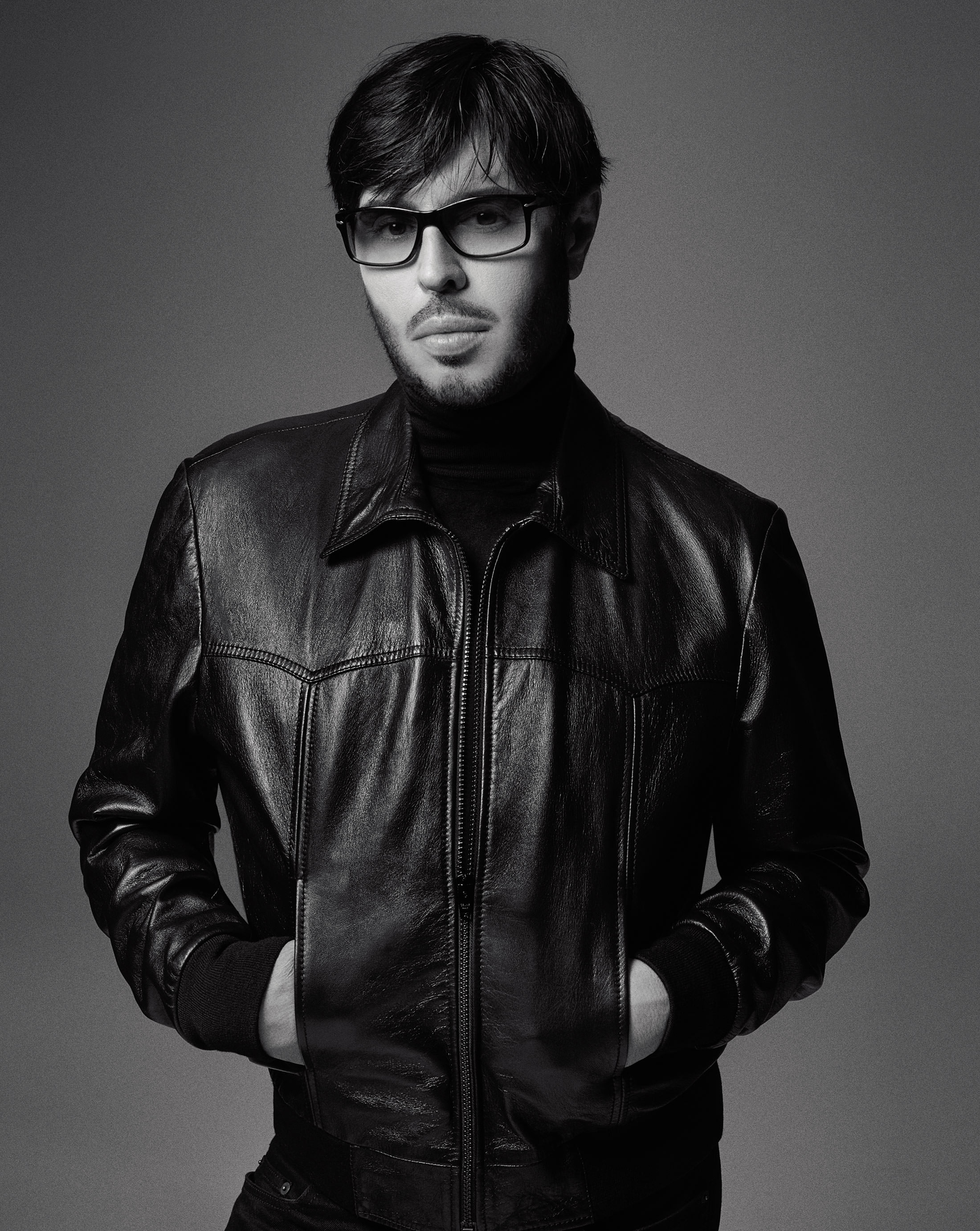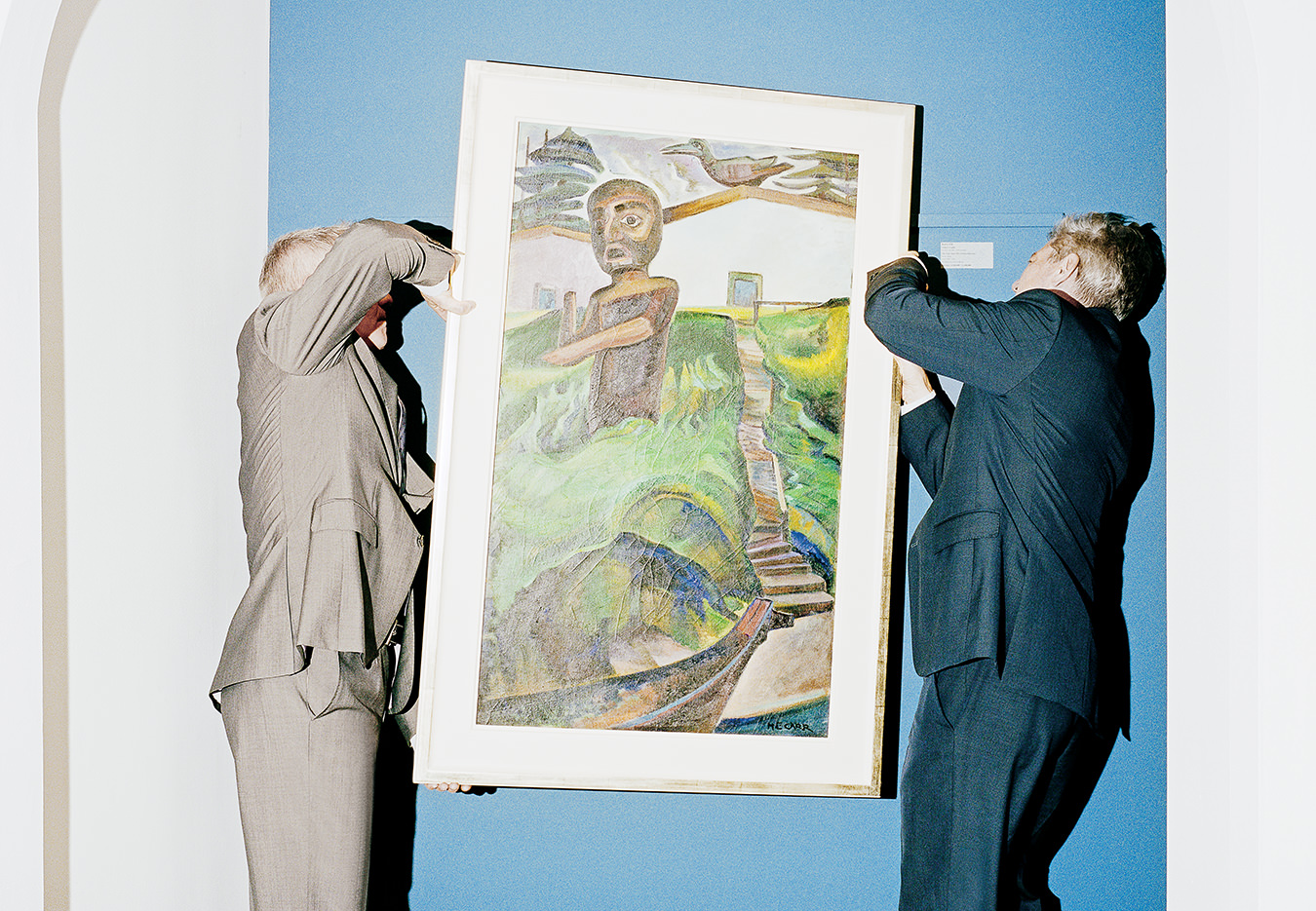François Nars, a Creative Visionary
Twenty-five years after launching his visionary makeup brand, François Nars has released his most ambitious collection yet.

Nars is wearing a Celine blazer and turtleneck, Saint Laurent jeans and boots, and his own glasses.
It’s an early September afternoon in New York, a few hours before the final run-through for Marc Jacobs’ spring 2015 fashion show. Models are milling about, chatting and looking at their phones. Classical music filters through the air, and no one seems in a hurry. François Nars, the French-born makeup artist who’s directing the beauty look of Jacobs’ show, is perhaps the most relaxed of all. In his tailored black suit and onyx-framed glasses, he’s catching up with friends and generally having a good time—not at all concerned about the empty makeup chairs around him. That’s because this season, Nars has pulled a radical move and has decided to forgo makeup. Instead, the squad of models—Binx Walton, Saskia de Brauw, and Edie Campbell among them—has received a few pats of moisturizer. And that’s it.
Rather than play into the makeup one-upmanship often displayed on the runway—crystal-studded eyelids! Faces covered in gold foil!—that year, Nars subverted the spectacle entirely. He simply said at the show, “I love makeup, but I also love seeing women without makeup. I like the idea that what you see is what you get.”
This kind of raw, come-as-you-are beauty has long defined the world of Nars, and more so than any other makeup artist, he has little to prove these days. Since founding NARS, the global cosmetic empire that bears his name, he has spent nearly three decades perfecting his brand of downtown glamour and grit, a mix of old-world elegance and rebellion. With a flick of graphic eyeliner or inky black-red lip stain, he’s transformed the faces of idiosyncratic beauties, from Isabella Rossellini to Naomi Campbell to Daphne Guinness. Despite being a makeup artist, he doesn’t care much for “pretty-pretty faces.” Instead, he’s drawn to “strong emotion in the face—a strong nose, high cheekbones. It’s not an obvious kind of beauty,” says the 60-year-old Frenchman. “Sometimes an ‘off’ face can become perfection because it has character and it’s interesting.”
When he launched his makeup brand in 1994—10 years after moving to New York from Paris in his 20s—Nars had little interest in doing what others expected. “There were good colours out there already, that was not the point,” says the revered creative. “The point was to put my name on a product and pick colours I was attracted to.” He opted for a range of 12 ultra-chic lipsticks with hypnotic names like Jungle Red, Shanghai Express, and Blonde Venus. “I didn’t want boring names like Cherry Red or Pink Strawberry. I wanted interesting names that would stick in your head and make women dream, create emotion, and give them an identity.” Later hits, including his phenomenally popular peachy-gold Orgasm blush, pitch-perfect Dolce Vita velvet matte lip pencil, and sultry bronze Monoï Body Glow, prove he has a magic touch for knowing exactly what women desire—and delivering it.
Nars, who was awarded the Chevalier de la Légion d’Honneur by the French government for his artistic contributions, recently delivered a follow-up to his original lipstick range. Called No Rules. Just Lips, the collection is his most ambitious yet, with a remarkable 60 colours—from bright red purple (Candy Stripper) to dusty mauve (Hot Kiss) to copper red (Hot Voodoo). “The demand is out there,” Nars says. “People want a lot of colours, they want choice. With the diversity of women, with all types of skin colours and skin tones, you want to give that choice, that freedom to pick what you want.” The formulas have come a long way since the ’80s, allowing for sheerer pigments with staying power. “The product lasts on the skin,” he enthuses. “The lipsticks don’t bleed like they used to.”

Celine jacket and turtleneck; Saint Laurent jeans; Nars’ own glasses.
This year, Nars is also trying his hand—or rather nose—at something new: fragrance, a first for his visionary brand. “I could have done this 20 years ago,” he admits, explaining that he’s long been obsessed with scents. When he met superstar perfumer, Olivia Giacobetti, in 2012 through a mutual friend, the idea for the fragrance blossomed. “We speak the same beauty language; it was a perfect match,” he says. Called Audacious, the smoky floral draws inspiration from Motu Tane, the South Pacific island Nars purchased in 2000 after selling his brand to Shiseido (he still, however, retains full creative control). Rather than featuring tropical notes in an obvious way, Nars says he “wanted an interesting, odd fragrance that tells a story.”
Giacobetti translated Nars’ observations and experiences into a scent that pairs white frangipani with plumes of incense, and evokes the darkness of the island, “the storms, the volcanoes, the fires at night,” he says. “It’s the idea of combining darkness and white, that contrast.” Instead of having a model be its face, the scent, which debuts in September, stands by itself—in a translucent bottle, dipped in black and designed by Fabien Baron, his long-time friend and collaborator. Like Nars himself, the fragrance is quietly striking.
Growing up in Biarritz, in southwestern France, Nars developed an eye for unconventional beauty at an early age. An only child, he was surrounded by chic women. “My grandmother and mother were very elegant, beautiful ladies that woke me up to a certain type of beauty,” he says. He didn’t have many friends, and he admits, “I didn’t like school much—I wasn’t the greatest student.” Instead, he escaped into the world of cinema. “My parents were great movie lovers, and we would go to the movies a lot together. I would watch silent movies at home on special nights, with Garbo, Dietrich, and all the stars of the ’30s, which struck me and made me dream.”
The raw, come-as-you-are beauty has long defined the world of Nars, and more so than any other makeup artist, he has little to prove these days.
At age 15, he began exploring the power of pigment: “I started doing makeup on my aunt and mother, directing them in how to apply it.” He assembled his kit from his mother’s vanity—eyeshadows and lipsticks from Chanel, Yves Saint Laurent, Christian Dior—and looked at magazines like French Vogue (which in the mid-’70s had “incredible makeup artists and photographers”) for inspiration. “I learned by looking at models, and I tried to reproduce that on my mother. I could push and go a little wilder with her, less so on my grandmother,” he says, laughing.
As a boy, all Nars wanted was to “grow up fast, go to Paris, and start a life.” And he did just that, leaving his hometown at 18 to study at the Carita Institute on rue du Faubourg Saint-Honoré. It was there that he learned the finer points of lining eyes in pencil, setting makeup with powder, and doing lashes “very precisely”. After he completed his courses, Nars began assisting Olivier Échaudemaison, an influential makeup artist, who opened his eyes to more creative possibilities. Nars soon started booking jobs for French Vogue, ELLE, and Marie Claire, steadily carving out a name for himself.
In the early ’80s, his work caught the attention of the influential stylist Polly Mellen, who at the time was an editor at Vogue and, as Nars says, “was always searching for new talents.” Mellen convinced Nars to come to New York. “She felt I was bringing something new. I had a fresh eye on beauty and had a lighter touch with makeup,” he says. “I was one of the first to not put so much foundation on. It was a little bit of a revolution. I wanted to see freckles, personality, and not put a mask on the girl. Polly got that.” Nars arrived with a short list of photographers he wanted to work with—Guy Bourdin, Richard Avedon, Irving Penn, Steven Klein. “I was very focused. I wanted the best or nothing,” he says. “Otherwise, I thought I should go back to France and do something else.”

Saint Laurent jacket, jeans, and boots; Celine turtleneck; Nars’ own glasses.
A career-defining moment came in 1986 when Mellen booked Nars for a Vogue cover shoot with Avedon and the it-model of the era, Paulina Porizkova. As Nars describes it, Avedon had photographed Porizkova a number of times, but was never pleased with the result. When he arrived on set, Nars chose to relinquish the heavy blush and smoky eyes that reigned supreme in that decade. Instead, he left Porizkova’s hair damp, made her skin dewy, and swiped on what appears to be tinted lip balm. The image was shocking in its simplicity. “I decided to make her extremely soft—no obvious makeup, no dark eyeshadow. Just very clean, very fresh,” Nars recalled in his biography, François Nars, published by Rizzoli in 2016.
With his career on the rise, Nars found his place among the fashion regulars who defined downtown glamour in New York in the late ’80s and ’90s. On set—and in life—his close circle included models Linda Evangelista and Christy Turlington, and hairstylists such as Garren, Odile Gilbert (who was his first roommate in the city), and Oribe Canales. When not doing makeup for Vogue, Harper’s Bazaar, and ELLE, Nars was tapped for advertising campaigns—Versace, Calvin Klein, Ralph Lauren—and runway shows. He worked quickly and honed his eye for knowing when less is more, letting the character of the woman shine through.
Today, Nars has worked with many of his dream photographers. He’s moved behind the camera as well, having photographed his brand’s campaigns since 1996, featuring muses like Alek Wek and Tilda Swinton, and published six coffee table books, including X-Ray and Tahiti: Faery Lands. He regularly pays tribute to his creative heroes with limited edition collections, inspired by the saturated, distinctive colours of photographer Guy Bourdin, for example, or the deconstructed palette of modern artist Connor Tingley—collections obsessed over by NARS fans and driven by art, not strictly commerce. As the makeup artist says, with refreshing honesty, “I have the luxury to do what I want.”
These days, Nars travels to Motu Tane once a year for an extended period, and otherwise divides his time between Los Angeles and New York, where he works on up to eight collections a year. He no longer applies makeup backstage or on shoots, choosing instead to direct the looks and have the team execute his vision—with one notable exception. “I will always do my mom’s makeup,” the beauty mogul says, “no matter what.” 
François Nars was photographed for NUVO at Milk Studios in New York. Makeup by Lena Koro, NARS global artistic director, for Tracey Mattingly.
_________
Never miss a story. Sign up for NUVO’s weekly newsletter here.




